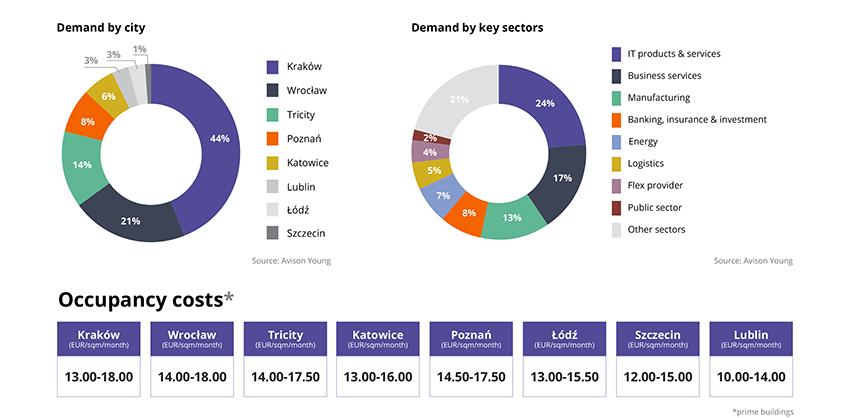2025-07-28
office

Poland’s regional office markets displayed both resilience and stagnation in the first half of 2025, according to Avison Young’s latest market snapshot. Despite sluggish new development, leasing activity rebounded, particularly in Kraków, which led the market in both demand and transaction volume. Market Overview As of mid-2025, Poland’s modern regional office stock stood at approximately 6.75 million sqm. However, only one project was delivered in H1 2025 — the Dymka 188 development in Poznań, adding just 2,400 sqm to the market. With only 67,400 sqm of new space expected by the end of the year, the supply pipeline remains historically limited. Development activity continues to be focused in Kraków and Poznań, where developer confidence remains relatively stronger compared to other cities. Demand Recovery and Transaction Structure The second quarter saw a 28% quarter-on-quarter increase in leasing activity across major regional cities, with total demand reaching 387,000 sqm. Kraków dominated with a 44% share, while Wrocław and Tricity collectively accounted for over one-third of total regional demand. A notable feature of the demand structure was the continued dominance of lease renegotiations, which made up nearly 60% of all leasing activity. New lease agreements constituted 32%, while pre-lets and owner-occupied transactions made up a small portion. The seven largest deals of the period — each exceeding 10,000 sqm — were all renewals. Sectoral Breakdown In terms of tenant industry, IT products and services led with 24% of the demand, followed by business services (17%) and manufacturing (13%). Flexible workspace operators, logistics, and the public sector also contributed notably to take-up across regions. Vacancy and Rental Trends The vacancy rate across regional markets held steady at 17.5%, with a total of 1.18 million sqm of vacant office space available. Katowice (22.7%) and Łódź (21.6%) recorded the highest vacancy rates, while Szczecin (7.3%) and Lublin (10.4%) had the lowest. Rental rates for prime office properties showed moderate variation. Kraków and Wrocław topped the list with monthly rents ranging from EUR 13.00–18.00/sqm, followed by Tricity (EUR 14.00–17.50/sqm). Lublin remained the most affordable, with rents from EUR 10.00 to 14.00/sqm/month. Outlook Avison Young expects regional office markets to remain in a state of subdued development through the remainder of 2025. Limited new supply could help reduce overall vacancy over time, though lease renegotiations will continue to dominate market dynamics due to few relocation options for tenants. “With development activity remaining low and few new office projects being delivered to the market, occupiers’ choices are increasingly constrained. As a result, starting the relocation process much earlier may become a key strategic approach,” said Przemysław Urbański, Director at Avison Young. On the investment side, regional cities recorded 13 office transactions totaling over €195 million in H1 2025, led by Stena Real Estate AB’s acquisition of High5ive I&II in Kraków — the second-largest office deal in the country for the period. While macroeconomic uncertainties and limited development may cap growth, steady tenant demand in select sectors and cities suggests a gradual path to stability for Poland’s regional office markets. Source: Avison Young

